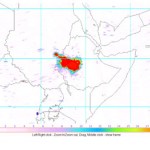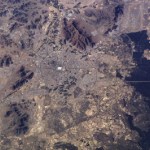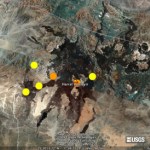speculation
Lava flows from the 2005 Mando Hararo eruption in Ethiopia.
Alright, I had been attempting to ignore this story because it was, well, a little uninteresting at first, but it apparently has legs so I will tackle it.
Slashdot has a post proclaiming:
'Volcanic activity may split the African continent in two, creating a new ocean, say experts. This is due to a recent geological crack which has appeared in northeastern Ethiopia.'
OK. Where do I start?
This is based on a recent study published in Geophysical Research Lettersthat found that the recent volcanism in Ethiopia is related to the active…
There have been a number of articles floating around the popular press for the last week that I thought I would touch on briefly ... always fun to decipher the real news from the hype.
Active fumaroles on Datun Mountain in Taipei.
An article out of the Taipei Times suggests that the city of Taipei in Taiwan is in great peril from Datun Mountain/volcano. The volcano, which was previously thought to have erupted ~200,000 years ago is now thought to have erupted only 5,000 years ago. That 195,000 years really does make a difference in terms of worrying about potential future eruptions, but…
The Atherton Tablelands in Far North Queensland, Australia.
Nothing makes me shudder like any article titled "Blankety-blank volcano is overdue". Typically the article that follows is full of nothing but vapid speculation and media fear-mongering. So, it wasn't too surprising that an article titled "Volcano eruption 'overdue'" in the Brisbane Times (amongst many other sites) didn't disappoint (or, in particular, it did). Dr. Bernie Joyce is quoted as saying "It is much more likely to be a matter of when, rather than if..." in regards to potential future volcanism on the Australian continent…
Eruptions reader Doug pointed out in a recent comment that the seismicity at Mt. Rainier in Washington has increased over the last month or so. Take a look for yourself:
Mt. Rainier seismicity over the last year (8/2008 to 9/2009). Image courtesy of PNSN
Taking a closer look, over the last week there has been 7 earthquakes over the last 5 days - all between M1-3 - near Rainier, most calculated to be between 1.5 to 5.8 km depth.
Any thoughts? I see a lot more noise (earthquakes) between 3-6 km depth. It could as benign as seismicity due to fluid in the extensive hydrothermal system at Rainier…
Undated photo of Shiveluch volcano in Russia.
In case you haven't seen the report yet, Shiveluch in Kamchatka has gone, as they say, "non-linear". KVERT has raised the alert level at the volcano to "Red" with reports of many strong explosions and an ash plume of >32,800 feet / >10 km. This all suggests that the volcano might have experienced [WARNING SPECULATION] a massive dome collapse followed by rapid decompression of the magma under the dome - causing the plinian eruption that seems to be underway. The size of this eruption plume will definitely have some effect on air travel over…
Lets get right to it!
"Manmade volcanoes": can they solve global warming?
It does indeed seem that something is happening beneath Kanlaon in the Philippines. PHIVOLCS reports that the volcano experienced 257 volcanic earthquakes from August 23 to September 1, well above the usually "background" level of ~20-30 a week. Most of this seismicity is centered on the northwest slope of the volcano, suggesting that if magma is moving, it is moving up under this side of the system. However, the seismicity doesn't necessarily have to be magma moving up to erupt. It could very easily be moving up in…
Quick hit post from beautiful Walnut, Iowa, but this was too interesting to pass up...
Bright plume spotted on Venus, image taken by the ESA Venus Express.
Did a volcanic eruption recently occur on Venus? No one really knows, but a bright plume of unknown material was spotted by an amateur astronomer. One possible source for this plume might be a volcanic eruption. In the first articles, it was dismissed by "experts" because it is believed that Venus mostly has effusive (lava flow) eruptions not explosive eruptions that form big ash-laden plumes. However, basaltic eruptions on Earth (as it…
Shishaldin volcano in Alaska.
Yesterday I mentioned in the SI/USGS Weekly Report update that things appear to be afoot at Shishaldin in the Aleutians. Well, I checked the Shishaldin webicorder today and indeed, [SPECULATION] something seems suspect. Now, the increasing signal might be wholly unrelated to any magmatic activity, but it is interesting to see an increase in the seismicity after the increase in the intensity of thermal anomaly at the summit crater.
AVO's latest statement (from yesterday) seems to think that nothing too much is up:
Cloudy conditions prevented views of Shishaldin…
Two papers submitted, one to go. Keeps you quite busy, let me tell you.
Lava flow from a 2006 eruption on Mayon in the Philippines.
A few bits of news today:
A few more details about the ongoing watch of Mayon in the Philippines . There have been apparently no changes in the shape of the floor of the crater as you might expect if magma was rising underneath. However, there has been an overall inflation of Mayon since the unrest began a few weeks ago. PHIVOLCS will be checking the sulfur dioxide and carbon dioxide output of the volcano soon as well.
Lots of articles this week about the "…
Three days ago, I received an email from Eruptions reader Gijs de Reijke who was curious about something he noticed in the daily OMI SO2 images:
OMI sulfur dioxide map over Ethiopia for June 30, 2009.
Now, I wasn't quite sure what to make of it other than the fact that there was an awful lot of sulfur dioxide in the vicinity of Addis Ababa, which seemed odd. If we look at a map of the active volcanoes in Ethiopia (below), a majority of the ones we might suspect if the SO2 was volcano are to the north (Erte Ale, Dallafilla), but this patch is smack-dab in the middle of the country, looking…
Chaiten in Chile erupting in January 2009. Even after over a year of activity, Eruptions readers are still captivated by the volcano.
Thanks for sending me your questions about volcanoes and volcanism. I'll try to tackle some hear - but as always, keep the questions coming! Send them to
For those of you who have submitted a question but don't see the answer here, do not fret. Likely it just means that I needed to do a little more research into the question and will get to it in a later mailbag!
So, without further ado ...
Mark M.: Here in the Appalachians we have very dense crystalline rock…
I won't try to recap all the news from last week, but I did notice a few articles from this weekend worth noting:
The Big Obsidian Flow at Newberry Volcano. This rhyolite lava flow erupted at ~1,300 years ago.
Geologists in Greece are keeping an eye on a submarine volcano called Columbus. Apparently a number of M4+ earthquakes have been reported, the sea floor has deformed and there have been "hot air eruption" (? ... I am a little skeptical of the last one without more details). The article is a little fuzzy on the details: the volcano is 6.5 meters southeast of Santorini and the Santorini…
Mt. Saint Helens in Washington state, USA
I'm back from my sojourn to New England and its time to play catch up. First things first!
There has been a lot of chatter in my inbox and on the comments here at Eruptions about the study/press release from Graham Hill's research group talking about the potential for a supervolcano forming at Mt. Saint Helens. This study (presented at the AGU Spring Meeting) was based on a magnetotelluric study of the area around (and below) Saint Helens. For those of you unfamiliar with magnetotellurics, it uses instruments that measure the magnetism and electrical…
Turrialba volcano in Costa Rica.
Turrialba, one of Costa Rica's active volcanoes, is apparently showing signs of life according to a brief report by Teletica 7 (in spanish). There is increased seismic activity and elevated gas emissions at the volcano that last erupted in 2007* and 1866 prior to that. The fumarolic activity at the summit crater is not a new occurrence, however the report implies that it has gotten more intense as the volcano has experienced increasing seismicity since early May. The Volcanism Blog does have an excellent summary of the rumblings at Turrialba since earlier in…
Fissures formed by seismicity in the Al-Ais region of Saudi Arabia. Image courtesy of Ahmed Al-Hussaini.
Although it seemed last week that the earthquakes in western Saudi Arabia were subsiding last week, there have been a number of reports that there was still significant seismicity in the area over the weekend. Earthquakes in the M2.5-3.5 range occurred on Saturday - both of which the SGS are attributing to "subterranean volcanic activity." This has prevented the evacuees from the Al-Ais region to return to their homes. The Saudi government has begun to assess how much effect this activity…
UPDATE 5/21/2009 4:30 PM Pacific: The latest news suggests that there are little to no evidence of volcanic gases since Wednesday according to the SGS, but they continue to monitor.
Lava flows from a 1256 A.D. eruption near Medinah in Saudi Arabia (to the south of Harrat Lunayyir) taken by the crew of the ISS in 2004. It shows nicely the volcanic heritage (dark lava flow on right of image) in western Saudi Arabia. Image courtesy of JSC Earth Observation Lab.
Well, as the days go by, there are more and more indications that an eruption is about to occur in the Harrat Lunayyir region of Saudi…
I have finally gotten together enough to create a Google Earth image (below) of the location of the Saudi Arabian earthquakes and their depths/magnitudes. I only have the data from the USGS earthquake list, but it is very illuminating:
Harrat Lunayyir volcano in western Saudi Arabia from Google Earth with the current earthquakes shown on the image. Image courtesy of Google, earthquake data from the USGS. Click here to see a larger version.
The earthquakes look like this (all times are Universal Time):
Date Time Mag. Depth
5/17 19:50 M4.6 10 km
5/19 06:38 M4.9 10 km
5/19 16:54 M4.9 10 km
5/19…
Al-Qider volcano in western Saudi Arabia. Image courtesy of Ahmed Al-Hussaini
The intense seismicity occurring underneath the Al-Eis region in Saudi Arabia has reached a point where Saudi Arabian officials are requiring 60,000 people who live in the region to evacuate. This is after M4.6 and M5.4 earthquakes that occurred Tuesday night (Saudi time). Saudi officials have also begun to build shelters for people affected by the earthquakes.
Now, the direct connection to a potential eruption is still very much in the air, but the earthquakes are still centered underneath known Holocene volcanic…
Al-Baidha volcanoAl-Qider volcano in Saudi Arabia. Image courtesy of Ahmed Al-Hussaini.
I've been searching for more information on the Saudi Arabian earthquake swarm reported last week. A number of Eruptions readers have also added some on-the-ground info as well.
UPDATE 12:30PM Pacific: Here is a brief update via Reuters India. They mention that five villages are being evacuated as a precaution. Beyond that, not much new information and it does feature this line that makes me shudder: "The region lies on a fault line, according to SGS, which declined to comment on current magma levels,…
The Harrat Khaybar volcanic field in Saudi Arabia. Image courtesy of NASA, taken in 2008.
Now, I might take this report with a Volvo-sized grain of salt, but I've seen a few reports lately of an earthquake swarm going on in Saudi Arabia, near the Harrat Ash-Shaqqah in Al-Eis region (apparently near Madina, but I'm not 100% sure). I might normally just chalk this up to the tectonics of the Arabian Plate, however, the latest article I read this morning, Saleh Al-Muhawis, Director General of the Civil Defense in Madina Region mentioned this as the cause of the seismicity:
... magma (molten…


